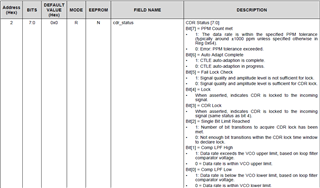Tool/software:
We are using the DS125DF111 XFI retimer in our current project. We are having some difficulty programming the retimer.
Could you please help review the sequence below and let us know if we are missing anything?
This is what we are writing to the register space:
|
Register |
Value |
R/W |
Reason |
|
0xFF |
0x0C |
W |
Broadcast to all channel |
|
0x0A[3:2] |
0x1C |
W |
CDR reset override |
|
W |
Enable CDR reset override |
||
|
0x60 |
0x00 |
W |
VCO frequency settings |
|
0x61 |
0xB2 |
W |
|
|
0x62 |
0x90 |
W |
|
|
0x63 |
0xB3 |
W |
|
|
0x64 |
0xCD |
W |
|
|
0x0A[3:2] |
0x1 |
W |
Release CDR reset |
Do we need to write back to 0xFF register space anything at the end to get the retimer to lock to the input?


